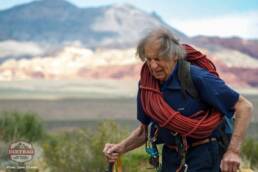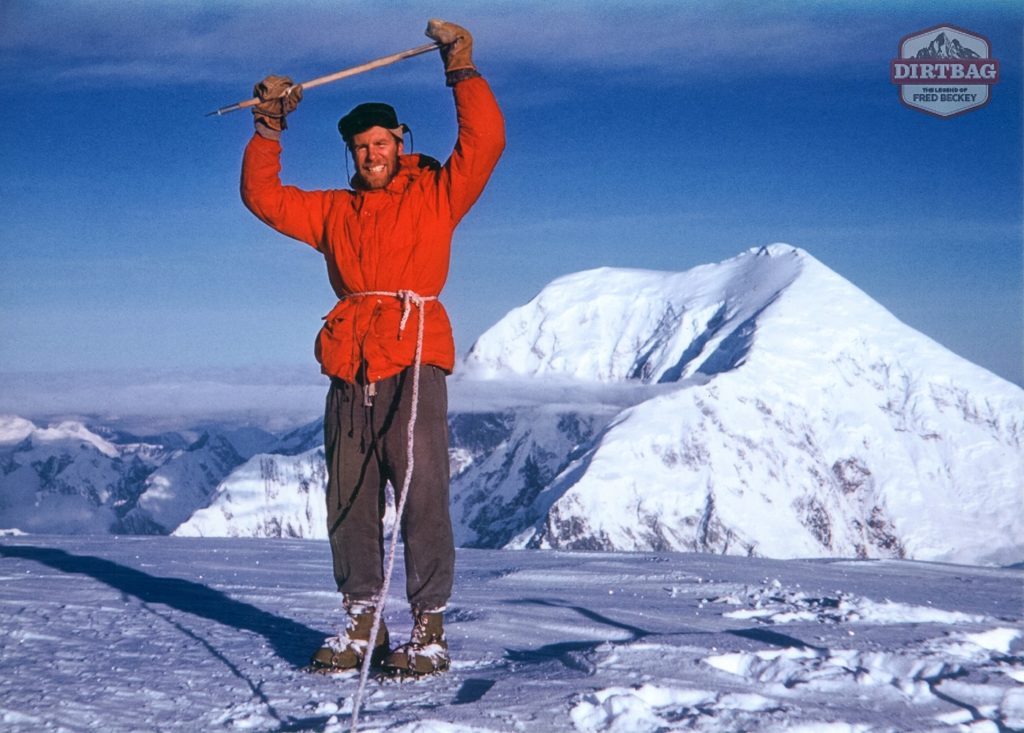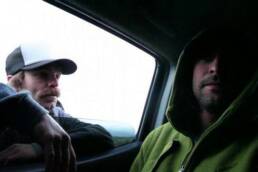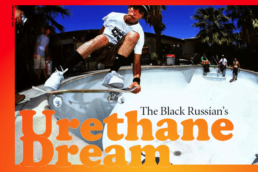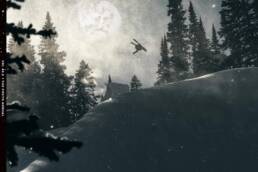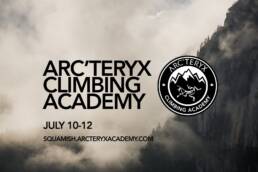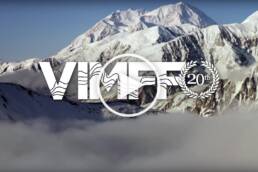Famed mountaineer Fred Beckey passed away peacefully on Monday, October 30 at the age of 94. In honour of his memory, we reprint this interview by Alain Denis that appeared in the Summer 2008 issue of Kootenay Mountain Culture magazine.
He can’t remember if he’s been married, doesn’t care about his mind-blowing mountaineering feats and likes Canada because “they leave you alone.” An interview with Fred Beckey, the world’s least known super athlete.
Improbable as it sounds, for anyone hoping to succeed Fred Beckey, the planet has run out of peaks. Born Wolfgang Gottfried Beckey in Dusseldorf, Germany, the remarkable mountaineer is regarded as having recorded more first ascents than any other climber in North America and, quite possibly, the world.
His parents — one a surgeon, the other an opera singer — fled post-World War One Germany for Seattle when he was three. In 1939, at age 16, Beckey made his first solo first-ascent on Washington’s Mount Despair, an imposing 2,223-metre (7,292- foot) peak in the nearby North Cascade Range, the barely charted playground for a relentless mountain icon in the making. BC’s Coast Range, Washington’s Cascades, Alaska, the Rockies, the Sierras, the Bugaboos: phenomenal firsts fell throughout the 1940s, 50s and 60s. A 2,591-metre (8,500-foot) peak in Alaska’s desolate Cathedral Mountains was named after Beckey shortly after he and a few friends staked its summit. He was 75 years old. Today, quite simply, there aren’t enough unclimbed mountains left for anyone to best Beckey’s legend.
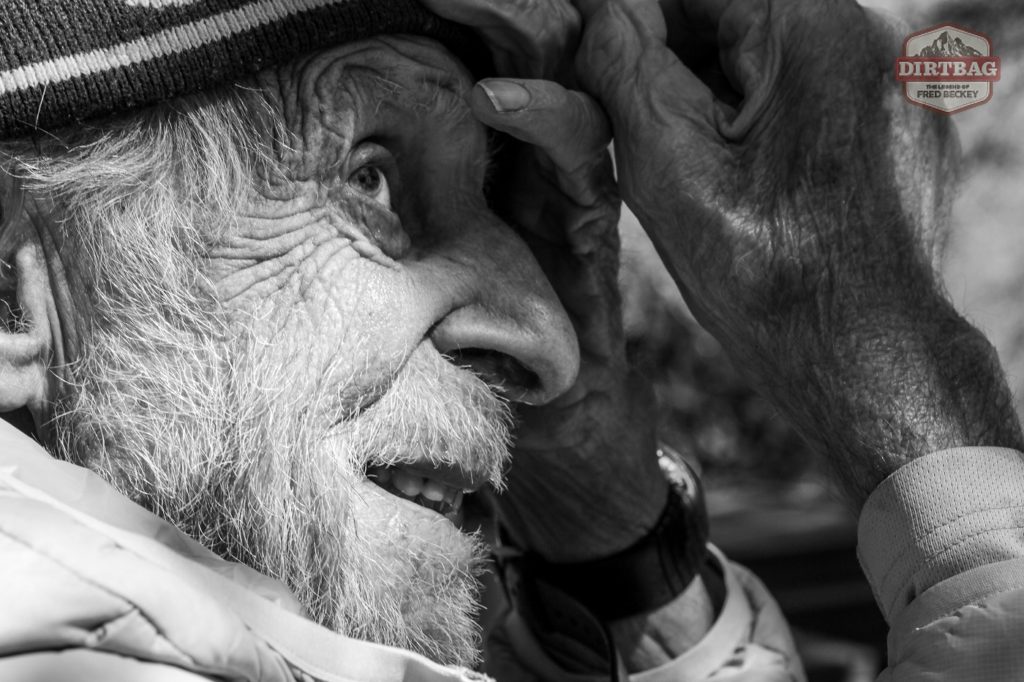
Forty years ago, Beckey was unexpectedly omitted from America’s successful Mount Everest expedition in 1963, and this footnote aptly defines his subtle outlaw persona. His humour, at times prickly and rough, Beckey has garnered the reverence of a living legend, while hanging beyond the clutch of media and industry hype. Of all the world’s most accomplished athletes, he’s likely the least known.
“I don’t know. I don’t care,” he said in an interview, when asked if he’s the greatest first-ascent climber of all. “I don’t want to claim that. There are people in Europe who have probably done more new routes.” His interest lies instead in recording fact. He has written more than ten books, including a 1,000-page, three-volume work on the Cascade Mountains. Late last year, Beckey was interviewed by Canadian photographer Alain Denis for Kootenay Mountain Culture Magazine in Salt Lake City, Utah. Denis, a 35-year-old photographer currently touring and climbing on a ’round-the-globe motorcycle trip, has shot adventure images throughout the Canadian Rockies, Europe, Pakistan, Laos and Mexico. Denis first met Beckey in 2002 at a Squamish, BC pub, where the legendary climber was reportedly “flirting with all the ladies at a slideshow.” He has since crashed on Denis’ sofa many times, for several days.
Alain Denis: What inspires you to climb?
Fred Beckey: Shit, I don’t really know. Why do people do any sports? I guess it’s the challenge and the [bit of] risk involved.
How old were you when you started climbing?
About 13 or 14. I started in the Boy Scouts.
When was your first road trip?
We went to the Grand Tetons [Wyoming]. We drove out there in a crappy old car for ten days.
How many first ascents have you done?
I really don’t know. I don’t keep track. A few hundred maybe. Depends if you’re talking about a first ascent of a peak or just a one or two-pitch climb.
How did you find them all?
I’ve always been interested in geography, so I read the guidebook, look at the map and go from there. If there’s no guidebook, I just look at the map.
So your main goal was always to climb new routes. Why?
I guess it’s more of a challenge finding our way up there with no information.
Over all those years and all those first ascents, was it a challenge finding partners?
Oh yeah. It used to be easier when you were college age, but when you get married and have kids, the wife usually says “no.”
Have you ever been married?
I don’t think so.
Have you ever wanted to get married?
Well it’s hard to say. I don’t know!
What year did you go into the Bugaboos?
1948 was the first year. We did the third ascent of Snowpatch [Spire].
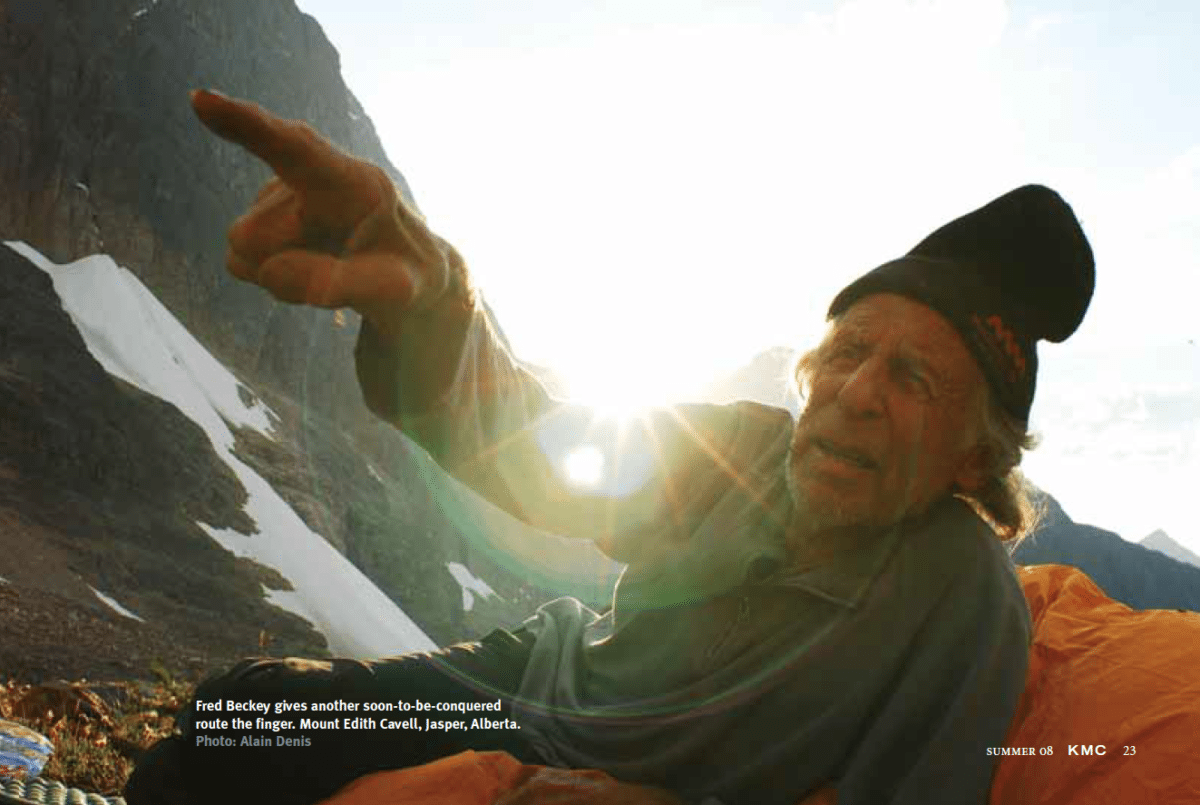
In those days, it must have been a long way in.
You know, it wasn’t that bad of a hike, because they had an old logging road. I don’t remember it being that bad. People got stuck, though, broke their axles, pretty muddy. You know, 5.9 driving.
When were your first trips overseas?
Everest. Lhotse expedition in 1955.
Did you summit? 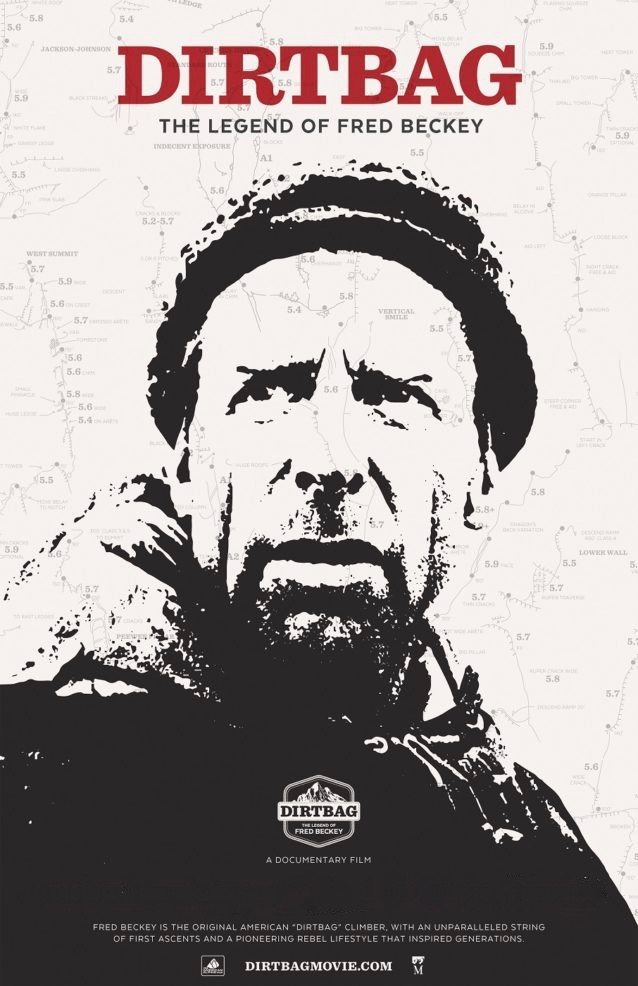
No. We had terrible weather. We got to about 23,000 feet.
Were you using oxygen?
Yeah, a little bit. We also did a first ascent of a peak near Lobuche. It’s a good steep climb.
What kind of gear did you use back in the early days?
Pitons and wooden blocks. Cams came out in 1973.
How do you find the time to do all these climbs and find the partners?
Well you have to network around, talk to people and line it up.
Who was your favourite partner?
I’ve had a lot of good partners, but I would have to say Eric Bjornstad, Hank Major, Gordon Thompson. Well, Gordon was a good guy but a little spacey. Hank liked to bullshit, but he was a very good climber.
Do you have a favourite peak in the Himalayas?
No, not really. They’re all good. I like the peaks in Alaska. The scenery’s nice. They’re brutal, though.
Do you prefer the peaks in Alaska to the Himalayas?
Well, I haven’t done that much in the Himalayas compared to Alaska. We went to India twice and China twice.
Have you ever had any life-threatening experiences climbing?
I think in 1938 in Colorado we had a bad avalanche come down. But we got out of it. Colorado’s got to be one of the most dangerous places out there.
Was there ever an expedition you did that involved more risk than all the others?
Well a few of them did, but Mount Hunter is the one that sticks out the most in my mind right now.
What year was that?
1954.
You did a lot of hard stuff in the early days?
Yeah, I guess so. 1954 was a good year, though. Really good year.
What’s your description of a climbing bum?
Ski bums are the worst. I don’t really have a description, but I know the ski bums are worse than the climbing bums.
What would you consider to be one of your favourite climbs?
Hard to say. I’d have to say maybe the north tower of Howser, or the north face of Edith Cavell.
Have you ever been on Mount Robson in the Canadian Rockies?
Yeah, we did the first winter ascent of the Kain Face in 1965 or ’66. We skied in.
What other sports do you enjoy?
Rock climbing, mountaineering and ski mountaineering. Nothing else.
What about ice climbing?
Yeah, I like it. But it’s brutal, though. I prefer rock climbing. I think ice climbing is a pretty risky sport. Will Gadd stuff. There are a lot of good climbers that have been killed ice climbing.
Have you ever done any big ski touring trips?
Yeah, we went to Waddington. We skied in from the coast and did the second ascent, with short summer skis.
What year was that?
1942.We went in by boat, then had to carry our skis for about eight miles before we hit snow. It took us about six weeks. No radio. No communication whatsoever. I wouldn’t do it again.
Was there ever a time, on any of your trips, you thought you might not get out alive?
Not really. But Waddington was a long ways in and few people knew where we were. If any of us got seriously hurt, it would have been weeks, if not months, before help arrived.
On his favourite mountain ranges:
I really like the Wind River Range [Cascades]. They’re a little bit like the Sierras. More remote, more wilderness and most of all less people. All these ranges have something good to offer, but everyone’s got their favourites. But I like the Coast Range better than the Cascades. Cascades have got too many roads, too many people. A big population problem. The forestry [department] comes up and tells you “you can’t park your car without paying” or “you need a snow pass.” What a bunch of baloney. Sign up for this. Sign up for that. Regulations. The thing I like about Canada is they leave you alone. As long as you’re not destructive and cut trees down or hurt anybody, they couldn’t care less where you are.
Any serious encounters with wildlife up in Canada?
Well, not really. But a few times we saw grizzlies and got a little scared. You see a grizzly and you get scared, you know?
What year was your first book?
Shit, can’t remember. 1948 maybe.
I heard you were working on a new book?
Yeah, it’s called Classic Climbs: Great Climbs from Alaska to Mexico.
So what’s your next mountain?
There are a few out there I want to do. Monarch would be nice. I’ve been on it but never to the summit. A beautiful place. Very alpine, big glaciers and nice scenery.
What would you consider to be a classic route of yours?
Well, it’s hard to say, but I guess the Beckey-Chouinard (route on the Bugaboos’ South Howser Tower) is a good one. It wasn’t that easy. We aided a bit but we weren’t concerned if it was free or not. That’s the way it always is. The main goal is always to get up, any way we can.
Related Stories
Interview with Sherpas Cinema
It's one of the most eagerly anticipated ski films in recent memory, with a trailer that blew minds with its lure of…
Urethane Dream – Interview With Josh Evin
Tragically, born and bred Kootenay skateboard icon, Josh Evin passed away on June 13, 2010. Josh was an amazing athlete…
Central Saanich Named Competition Climbing Capital of Canada
Photos by: Christian J. Stewart The Boulders Climbing Gym and the District of Central Saanich are pleased to announce…
Powder Magazine Unveils Cover Design For Final Edition
Powder Magazine has unveiled its cover design for the final edition and it's a nod to the very first issue printed in…
The 2015 Arc’teryx Climbing Academy Is Coming at You
Mark your calendars -- the Arc'teryx Climbing Academy in Squamish, BC is happening July 10-12, 2015!…
VIMFF 2017 Trailer Released
The Vancouver International Mountain Film Festival is celebrating its 20th Anniversary with one of the best line-ups of…


